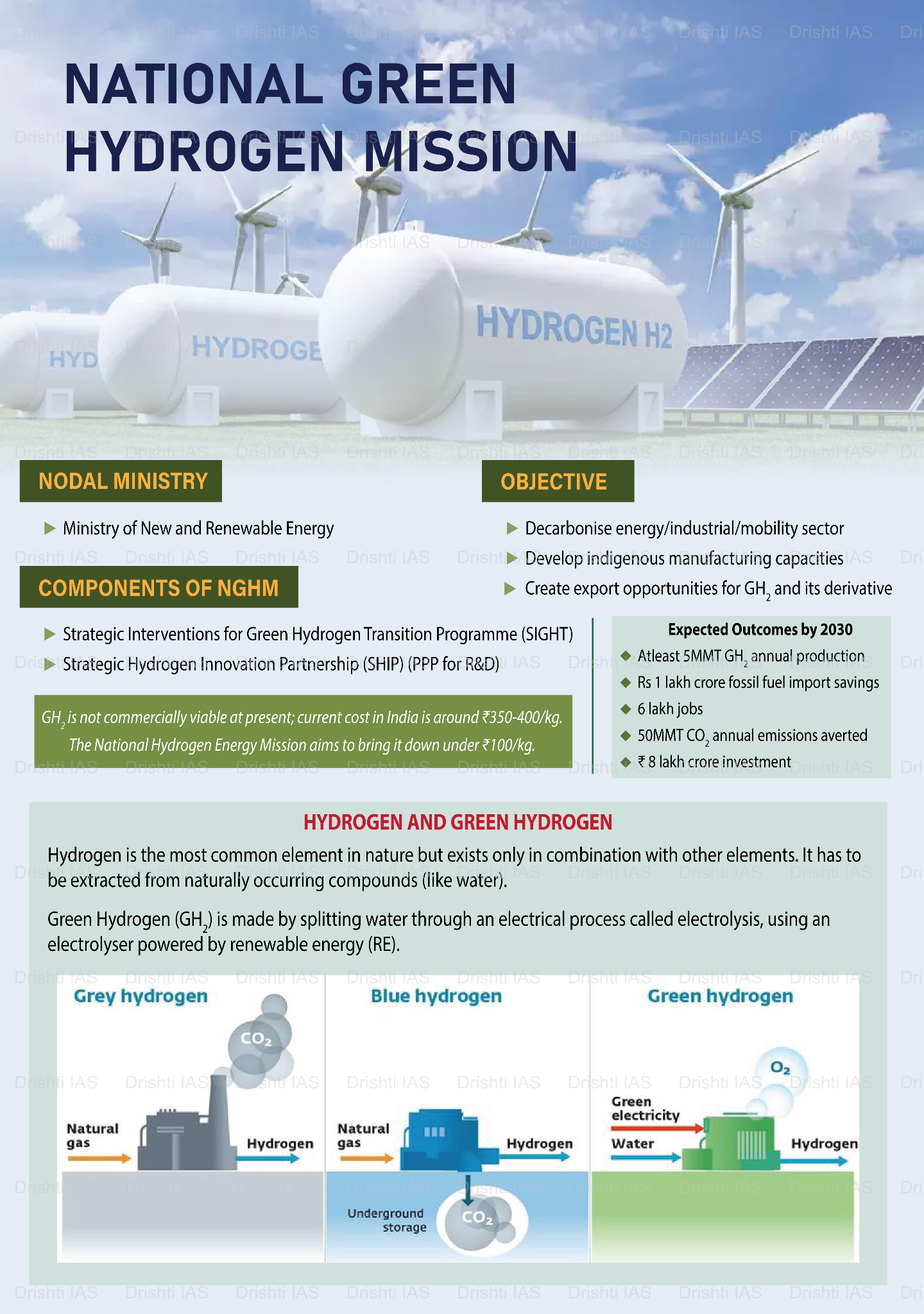Indian Economy
Pitfalls of India’s Green Hydrogen Move
- 28 Oct 2023
- 7 min read
For Prelims: Climate Risk Horizons (CRH), Green Hydrogen, National Green Hydrogen Mission, Renewable Energy, India’s Nationally Determined Contribution (INDCs), National Thermal Power Corporation.
For Mains: Issues in Green Hydrogen Production which fails to curb the fossil fuels emissions and environmental degradation.
Why in News?
According to a recent study by environmental and energy think-tank, Climate Risk Horizons (CRH), India's green hydrogen move may worsen pollution if steps are not in place to curb fossil fuel emissions in green hydrogen production.
- India’s National Green Hydrogen Mission, piloted by the Ministry of New and Renewable Energy (MNRE) expects to manufacture five million tonnes by 2030.
What is the Present Issue in Green Hydrogen Production?
- Definition of Green Hydrogen:
- The MNRE has defined green hydrogen as hydrogen production that emits no more than 2 kg of carbon dioxide per kg of hydrogen.
- However, this definition is currently subject to interpretation, raising concerns about its practical implementation.
- The MNRE has defined green hydrogen as hydrogen production that emits no more than 2 kg of carbon dioxide per kg of hydrogen.
- Continuous Operation of Electrolysers:
- If electrolysers (essential for green hydrogen production) run 24/7, they would need to operate at night when there is no solar power available. This would likely require drawing electricity from the conventional coal-fired grid, using which could increase carbon emissions.
- Lack of Transparency in Project Electricity Sources:
- The report notes that the majority of projects have not disclosed their electricity sources, and it remains unclear whether the few projects that have made commitments are meeting 100% of their electricity requirements from renewable sources.
What are the Implications of Green Hydrogen Production?
- Biomass Use and Green Hydrogen Production:
- India's standards for green hydrogen production permit the use of biomass, which, when burned, also generates carbon emissions. This introduces a challenge in achieving truly clean green hydrogen.
- Diversion of Renewable Energy Capacity:
- The production of green hydrogen requires a significant amount of renewable energy (RE) capacity. However, diverting a substantial portion of this capacity to green hydrogen production may result in insufficient clean electricity for consumers.
- This would require the installation of renewable energy capacity worth 125 GW, equivalent to about 13% of India’s present electricity generation.
- The risk of diverting finances from projects that would help decarbonize the electricity grid to green hydrogen production is a concern.
- The production of green hydrogen requires a significant amount of renewable energy (RE) capacity. However, diverting a substantial portion of this capacity to green hydrogen production may result in insufficient clean electricity for consumers.
- Industry Expansion and Investment:
- Several major power utilities in India, such as Reliance Industries, the Adani Group, and the National Thermal Power Corporation, have announced ambitious plans to increase their green hydrogen production where such concerns could deter further investments.
What is the Significance of Green Hydrogen?
- Achieving Emission Target:
- Green hydrogen energy is vital for India to meet its Nationally Determined Contribution (NDC) Targets and ensure regional and national energy security, access and availability.
- Under the Paris Climate Agreement, India pledged to reduce the emission intensity of its economy by 33-35% from 2005 levels by 2030. Green hydrogen can drive India’s transition to clean energy, combat climate change.
- Green hydrogen energy is vital for India to meet its Nationally Determined Contribution (NDC) Targets and ensure regional and national energy security, access and availability.
- Energy Storage and Mobility:
- Green Hydrogen can act as an energy storage option, which would be essential to meet intermittencies (of renewable energy) in the future.
- In terms of mobility, for long distance mobilizations for either urban freight movement within cities and states or for passengers, Green Hydrogen can be used in railways, large ships, buses or trucks, etc.
- Green Hydrogen can act as an energy storage option, which would be essential to meet intermittencies (of renewable energy) in the future.
- Reducing Import Dependence:
- It will reduce India’s import dependency on fossil fuels. The localisation of electrolyser production and the development of green hydrogen projects can create a new green technologies market in India worth USD 18-20 billion and thousands of jobs.
Way Forward
- Set a National Target for Green Hydrogen and Electrolyser Capacity: A phased manufacturing programme should be used to build a vibrant hydrogen products export industry in India such as green steel (commercial hydrogen steel plant).
- Implement Complementary Solutions that Create Virtuous Cycles: For example hydrogen infrastructure can be set up for refueling, heating and generating electricity at airports.
- Decentralized Production: Decentralized hydrogen production must be promoted through open access of renewable power to an electrolyser (which splits water to form H2 and O2 using electricity).
- Providing Finance: Policymakers must facilitate investments in early-stage piloting and the research and development needed to advance the technology for use in India.
UPSC Civil Services Examination Previous Year Question (PYQ)
Q. Consider the following heavy industries: (2023)
- Fertilizer plants
- Oil refineries
- Steel plants
Green hydrogen is expected to play a significant role in decarbonizing how many of the above industries?
(a) Only one
(b) Only two
(c) All three
(d) None
Ans: C
Q. With reference to green hydrogen, consider the following statements : (2023)
- It can be used directly as a fuel for internal combustion.
- It can be blended with natural gas and used as fuel for heat or power generation.
- It can be used in the hydrogen fuel cell to run vehicles.
How many of the above statements are correct?
(a) Only one
(b) Only two
(c) All three
(d) None
Ans: (c)
Q. Hydrogen fuel cell vehicles produce one of the following as “exhaust” (2010)
(a) NH3
(b) CH4
(c) H2O
(d) H2O2
Ans: (c)







